Chemistry Essentials
VerifiedAdded on 2022/10/06
|9
|2398
|73
AI Summary
This document covers the essentials of Chemistry including equilibrium, hemoglobin, oxidation, Boyle's law, intermolecular forces, and more. It also includes a formula for calculating K and the effects of physical conditions on matter.
Contribute Materials
Your contribution can guide someone’s learning journey. Share your
documents today.
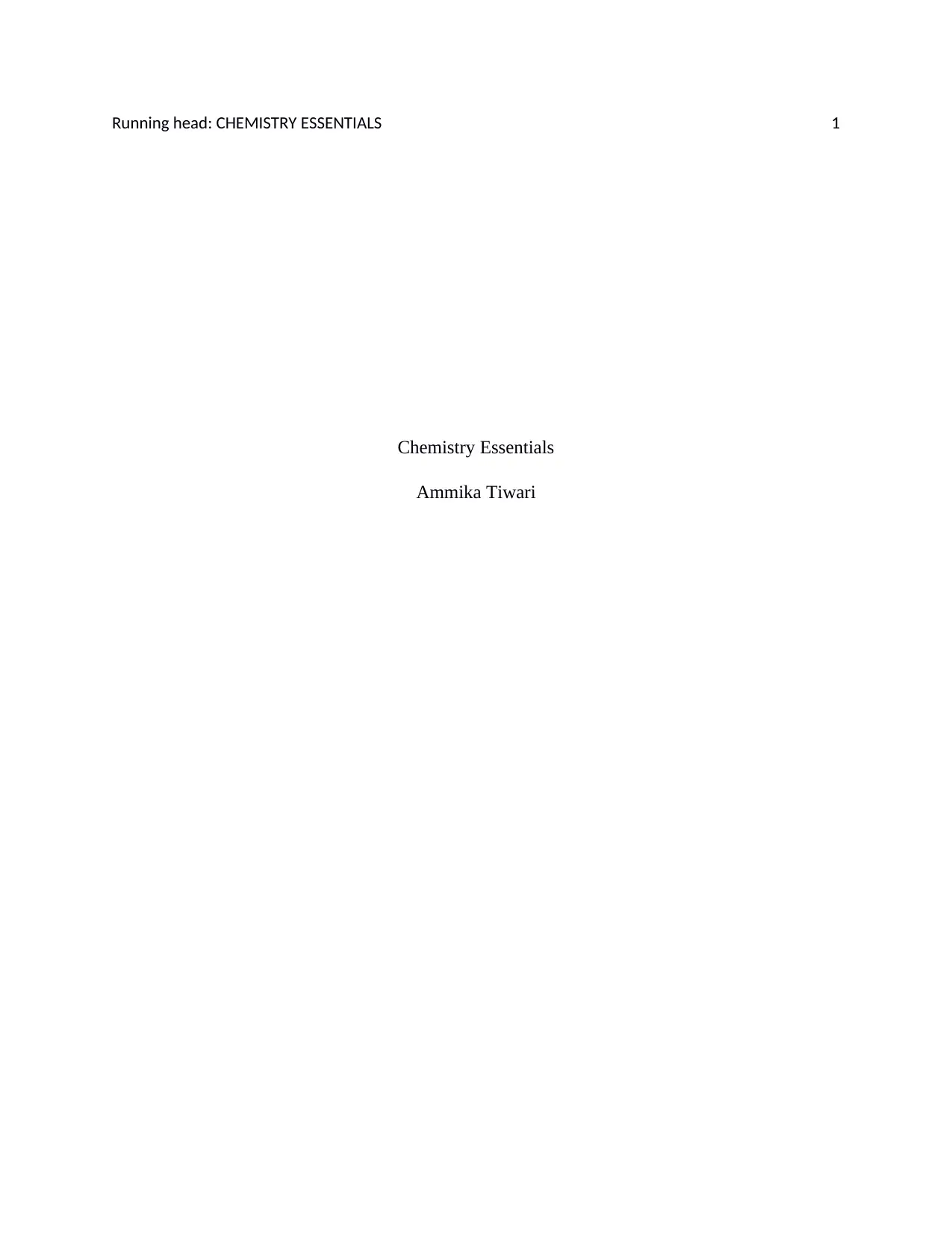
Running head: CHEMISTRY ESSENTIALS 1
Chemistry Essentials
Ammika Tiwari
Chemistry Essentials
Ammika Tiwari
Secure Best Marks with AI Grader
Need help grading? Try our AI Grader for instant feedback on your assignments.
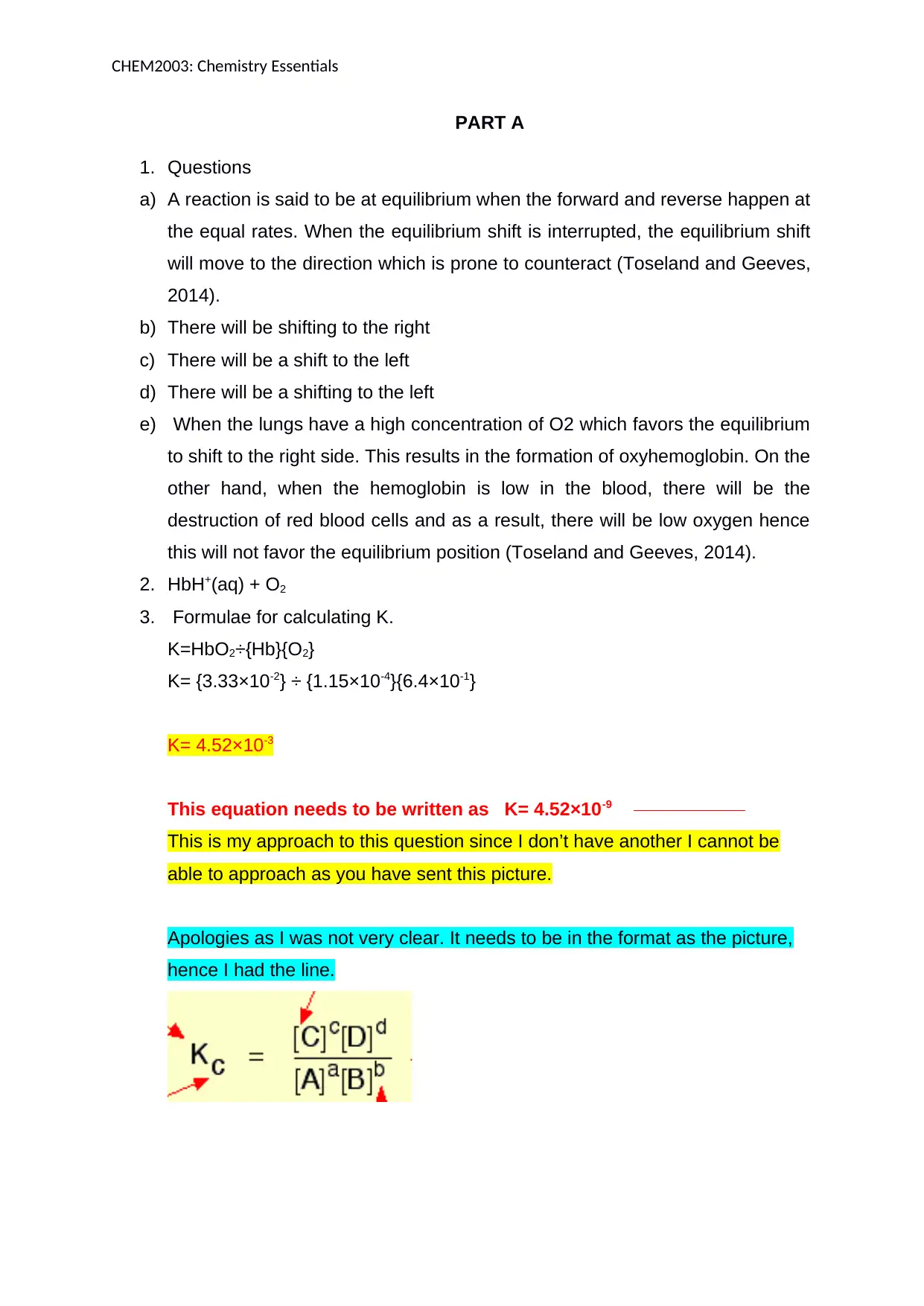
CHEM2003: Chemistry Essentials
PART A
1. Questions
a) A reaction is said to be at equilibrium when the forward and reverse happen at
the equal rates. When the equilibrium shift is interrupted, the equilibrium shift
will move to the direction which is prone to counteract (Toseland and Geeves,
2014).
b) There will be shifting to the right
c) There will be a shift to the left
d) There will be a shifting to the left
e) When the lungs have a high concentration of O2 which favors the equilibrium
to shift to the right side. This results in the formation of oxyhemoglobin. On the
other hand, when the hemoglobin is low in the blood, there will be the
destruction of red blood cells and as a result, there will be low oxygen hence
this will not favor the equilibrium position (Toseland and Geeves, 2014).
2. HbH+(aq) + O2
3. Formulae for calculating K.
K=HbO2÷{Hb}{O2}
K= {3.33×10-2} ÷ {1.15×10-4}{6.4×10-1}
K= 4.52×10-3
This equation needs to be written as K= 4.52×10-9
This is my approach to this question since I don’t have another I cannot be
able to approach as you have sent this picture.
Apologies as I was not very clear. It needs to be in the format as the picture,
hence I had the line.
PART A
1. Questions
a) A reaction is said to be at equilibrium when the forward and reverse happen at
the equal rates. When the equilibrium shift is interrupted, the equilibrium shift
will move to the direction which is prone to counteract (Toseland and Geeves,
2014).
b) There will be shifting to the right
c) There will be a shift to the left
d) There will be a shifting to the left
e) When the lungs have a high concentration of O2 which favors the equilibrium
to shift to the right side. This results in the formation of oxyhemoglobin. On the
other hand, when the hemoglobin is low in the blood, there will be the
destruction of red blood cells and as a result, there will be low oxygen hence
this will not favor the equilibrium position (Toseland and Geeves, 2014).
2. HbH+(aq) + O2
3. Formulae for calculating K.
K=HbO2÷{Hb}{O2}
K= {3.33×10-2} ÷ {1.15×10-4}{6.4×10-1}
K= 4.52×10-3
This equation needs to be written as K= 4.52×10-9
This is my approach to this question since I don’t have another I cannot be
able to approach as you have sent this picture.
Apologies as I was not very clear. It needs to be in the format as the picture,
hence I had the line.
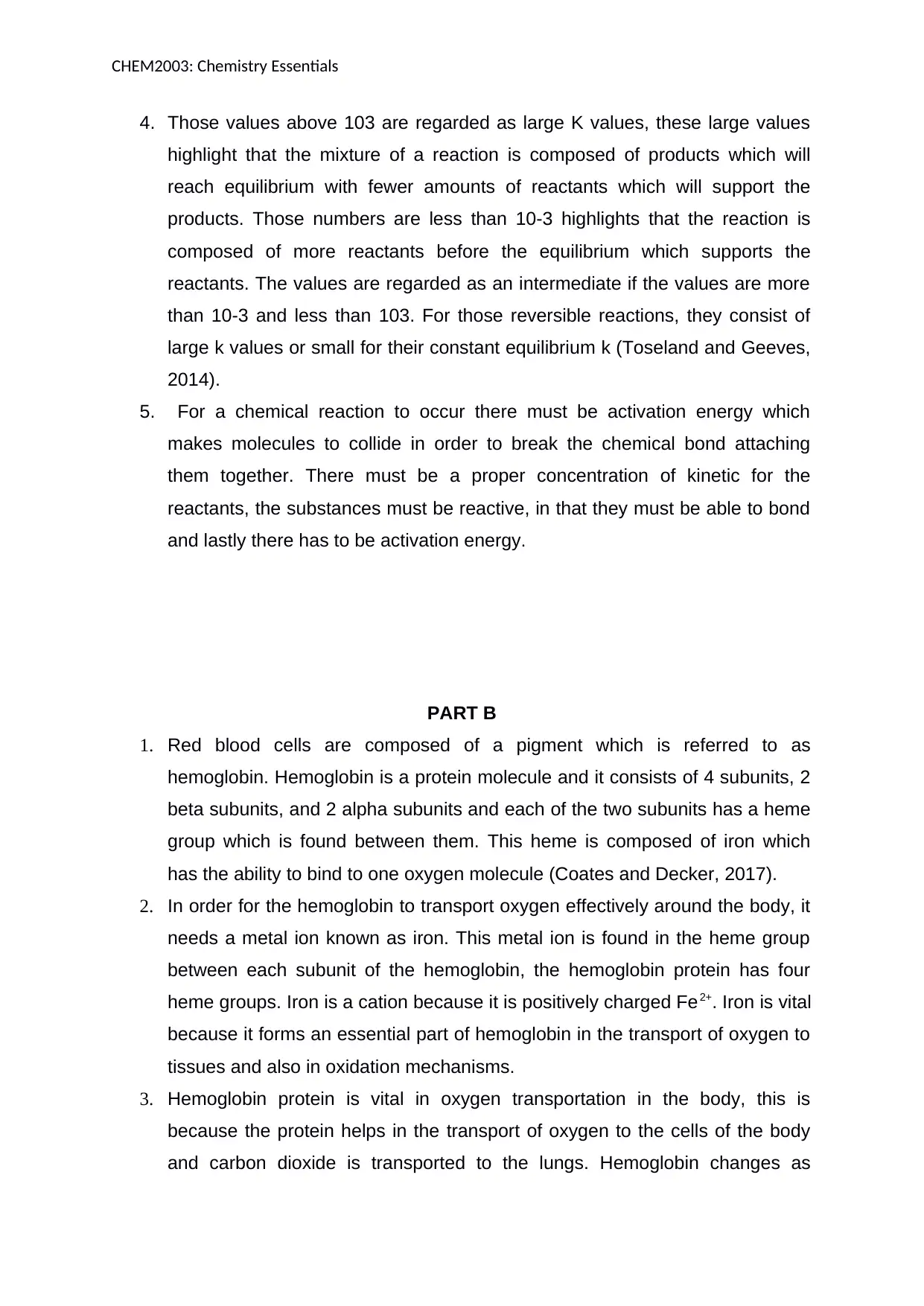
CHEM2003: Chemistry Essentials
4. Those values above 103 are regarded as large K values, these large values
highlight that the mixture of a reaction is composed of products which will
reach equilibrium with fewer amounts of reactants which will support the
products. Those numbers are less than 10-3 highlights that the reaction is
composed of more reactants before the equilibrium which supports the
reactants. The values are regarded as an intermediate if the values are more
than 10-3 and less than 103. For those reversible reactions, they consist of
large k values or small for their constant equilibrium k (Toseland and Geeves,
2014).
5. For a chemical reaction to occur there must be activation energy which
makes molecules to collide in order to break the chemical bond attaching
them together. There must be a proper concentration of kinetic for the
reactants, the substances must be reactive, in that they must be able to bond
and lastly there has to be activation energy.
PART B
1. Red blood cells are composed of a pigment which is referred to as
hemoglobin. Hemoglobin is a protein molecule and it consists of 4 subunits, 2
beta subunits, and 2 alpha subunits and each of the two subunits has a heme
group which is found between them. This heme is composed of iron which
has the ability to bind to one oxygen molecule (Coates and Decker, 2017).
2. In order for the hemoglobin to transport oxygen effectively around the body, it
needs a metal ion known as iron. This metal ion is found in the heme group
between each subunit of the hemoglobin, the hemoglobin protein has four
heme groups. Iron is a cation because it is positively charged Fe2+. Iron is vital
because it forms an essential part of hemoglobin in the transport of oxygen to
tissues and also in oxidation mechanisms.
3. Hemoglobin protein is vital in oxygen transportation in the body, this is
because the protein helps in the transport of oxygen to the cells of the body
and carbon dioxide is transported to the lungs. Hemoglobin changes as
4. Those values above 103 are regarded as large K values, these large values
highlight that the mixture of a reaction is composed of products which will
reach equilibrium with fewer amounts of reactants which will support the
products. Those numbers are less than 10-3 highlights that the reaction is
composed of more reactants before the equilibrium which supports the
reactants. The values are regarded as an intermediate if the values are more
than 10-3 and less than 103. For those reversible reactions, they consist of
large k values or small for their constant equilibrium k (Toseland and Geeves,
2014).
5. For a chemical reaction to occur there must be activation energy which
makes molecules to collide in order to break the chemical bond attaching
them together. There must be a proper concentration of kinetic for the
reactants, the substances must be reactive, in that they must be able to bond
and lastly there has to be activation energy.
PART B
1. Red blood cells are composed of a pigment which is referred to as
hemoglobin. Hemoglobin is a protein molecule and it consists of 4 subunits, 2
beta subunits, and 2 alpha subunits and each of the two subunits has a heme
group which is found between them. This heme is composed of iron which
has the ability to bind to one oxygen molecule (Coates and Decker, 2017).
2. In order for the hemoglobin to transport oxygen effectively around the body, it
needs a metal ion known as iron. This metal ion is found in the heme group
between each subunit of the hemoglobin, the hemoglobin protein has four
heme groups. Iron is a cation because it is positively charged Fe2+. Iron is vital
because it forms an essential part of hemoglobin in the transport of oxygen to
tissues and also in oxidation mechanisms.
3. Hemoglobin protein is vital in oxygen transportation in the body, this is
because the protein helps in the transport of oxygen to the cells of the body
and carbon dioxide is transported to the lungs. Hemoglobin changes as
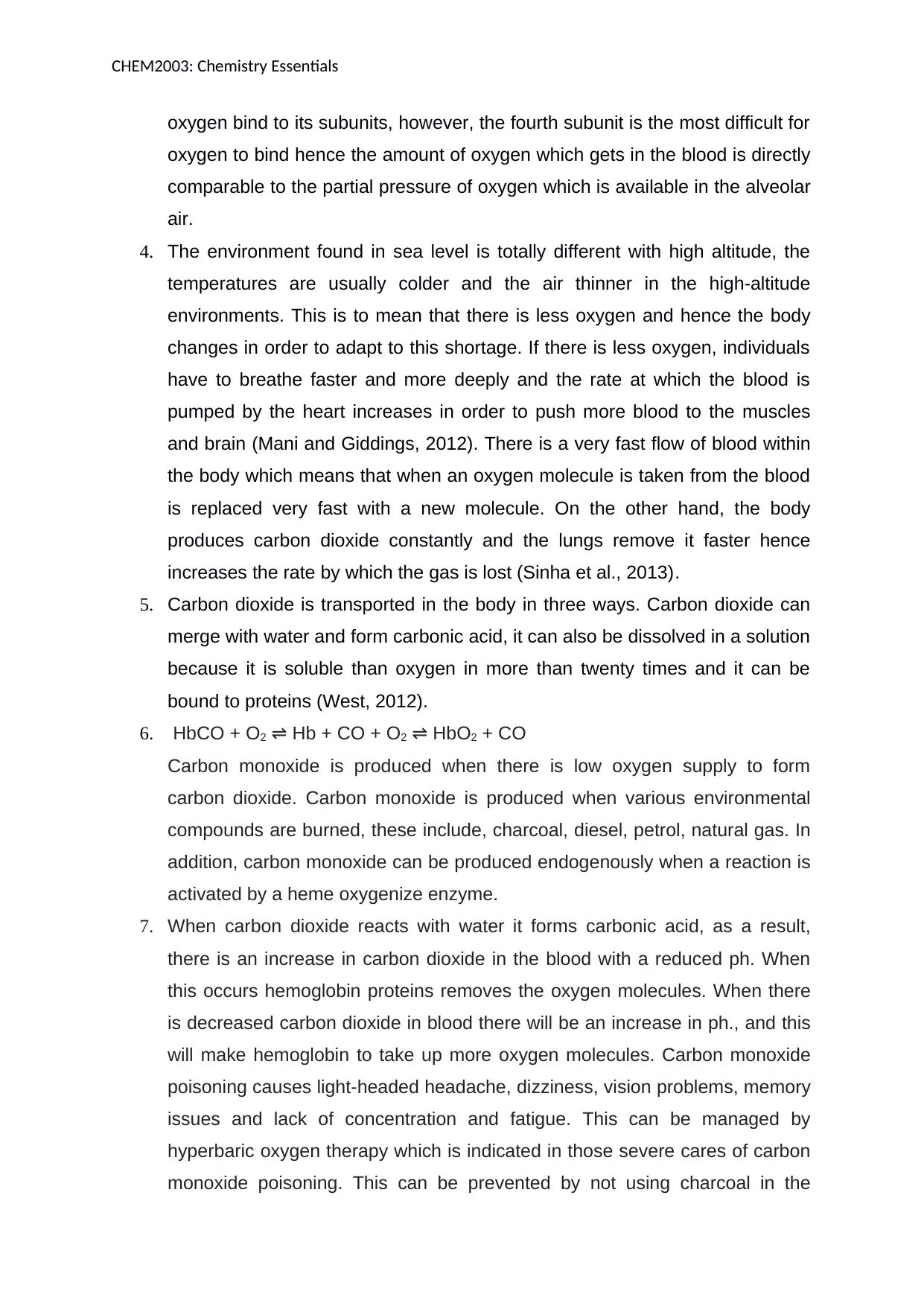
CHEM2003: Chemistry Essentials
oxygen bind to its subunits, however, the fourth subunit is the most difficult for
oxygen to bind hence the amount of oxygen which gets in the blood is directly
comparable to the partial pressure of oxygen which is available in the alveolar
air.
4. The environment found in sea level is totally different with high altitude, the
temperatures are usually colder and the air thinner in the high-altitude
environments. This is to mean that there is less oxygen and hence the body
changes in order to adapt to this shortage. If there is less oxygen, individuals
have to breathe faster and more deeply and the rate at which the blood is
pumped by the heart increases in order to push more blood to the muscles
and brain (Mani and Giddings, 2012). There is a very fast flow of blood within
the body which means that when an oxygen molecule is taken from the blood
is replaced very fast with a new molecule. On the other hand, the body
produces carbon dioxide constantly and the lungs remove it faster hence
increases the rate by which the gas is lost (Sinha et al., 2013).
5. Carbon dioxide is transported in the body in three ways. Carbon dioxide can
merge with water and form carbonic acid, it can also be dissolved in a solution
because it is soluble than oxygen in more than twenty times and it can be
bound to proteins (West, 2012).
6. HbCO + O2 ⇌ Hb + CO + O2 ⇌ HbO2 + CO
Carbon monoxide is produced when there is low oxygen supply to form
carbon dioxide. Carbon monoxide is produced when various environmental
compounds are burned, these include, charcoal, diesel, petrol, natural gas. In
addition, carbon monoxide can be produced endogenously when a reaction is
activated by a heme oxygenize enzyme.
7. When carbon dioxide reacts with water it forms carbonic acid, as a result,
there is an increase in carbon dioxide in the blood with a reduced ph. When
this occurs hemoglobin proteins removes the oxygen molecules. When there
is decreased carbon dioxide in blood there will be an increase in ph., and this
will make hemoglobin to take up more oxygen molecules. Carbon monoxide
poisoning causes light-headed headache, dizziness, vision problems, memory
issues and lack of concentration and fatigue. This can be managed by
hyperbaric oxygen therapy which is indicated in those severe cares of carbon
monoxide poisoning. This can be prevented by not using charcoal in the
oxygen bind to its subunits, however, the fourth subunit is the most difficult for
oxygen to bind hence the amount of oxygen which gets in the blood is directly
comparable to the partial pressure of oxygen which is available in the alveolar
air.
4. The environment found in sea level is totally different with high altitude, the
temperatures are usually colder and the air thinner in the high-altitude
environments. This is to mean that there is less oxygen and hence the body
changes in order to adapt to this shortage. If there is less oxygen, individuals
have to breathe faster and more deeply and the rate at which the blood is
pumped by the heart increases in order to push more blood to the muscles
and brain (Mani and Giddings, 2012). There is a very fast flow of blood within
the body which means that when an oxygen molecule is taken from the blood
is replaced very fast with a new molecule. On the other hand, the body
produces carbon dioxide constantly and the lungs remove it faster hence
increases the rate by which the gas is lost (Sinha et al., 2013).
5. Carbon dioxide is transported in the body in three ways. Carbon dioxide can
merge with water and form carbonic acid, it can also be dissolved in a solution
because it is soluble than oxygen in more than twenty times and it can be
bound to proteins (West, 2012).
6. HbCO + O2 ⇌ Hb + CO + O2 ⇌ HbO2 + CO
Carbon monoxide is produced when there is low oxygen supply to form
carbon dioxide. Carbon monoxide is produced when various environmental
compounds are burned, these include, charcoal, diesel, petrol, natural gas. In
addition, carbon monoxide can be produced endogenously when a reaction is
activated by a heme oxygenize enzyme.
7. When carbon dioxide reacts with water it forms carbonic acid, as a result,
there is an increase in carbon dioxide in the blood with a reduced ph. When
this occurs hemoglobin proteins removes the oxygen molecules. When there
is decreased carbon dioxide in blood there will be an increase in ph., and this
will make hemoglobin to take up more oxygen molecules. Carbon monoxide
poisoning causes light-headed headache, dizziness, vision problems, memory
issues and lack of concentration and fatigue. This can be managed by
hyperbaric oxygen therapy which is indicated in those severe cares of carbon
monoxide poisoning. This can be prevented by not using charcoal in the
Secure Best Marks with AI Grader
Need help grading? Try our AI Grader for instant feedback on your assignments.
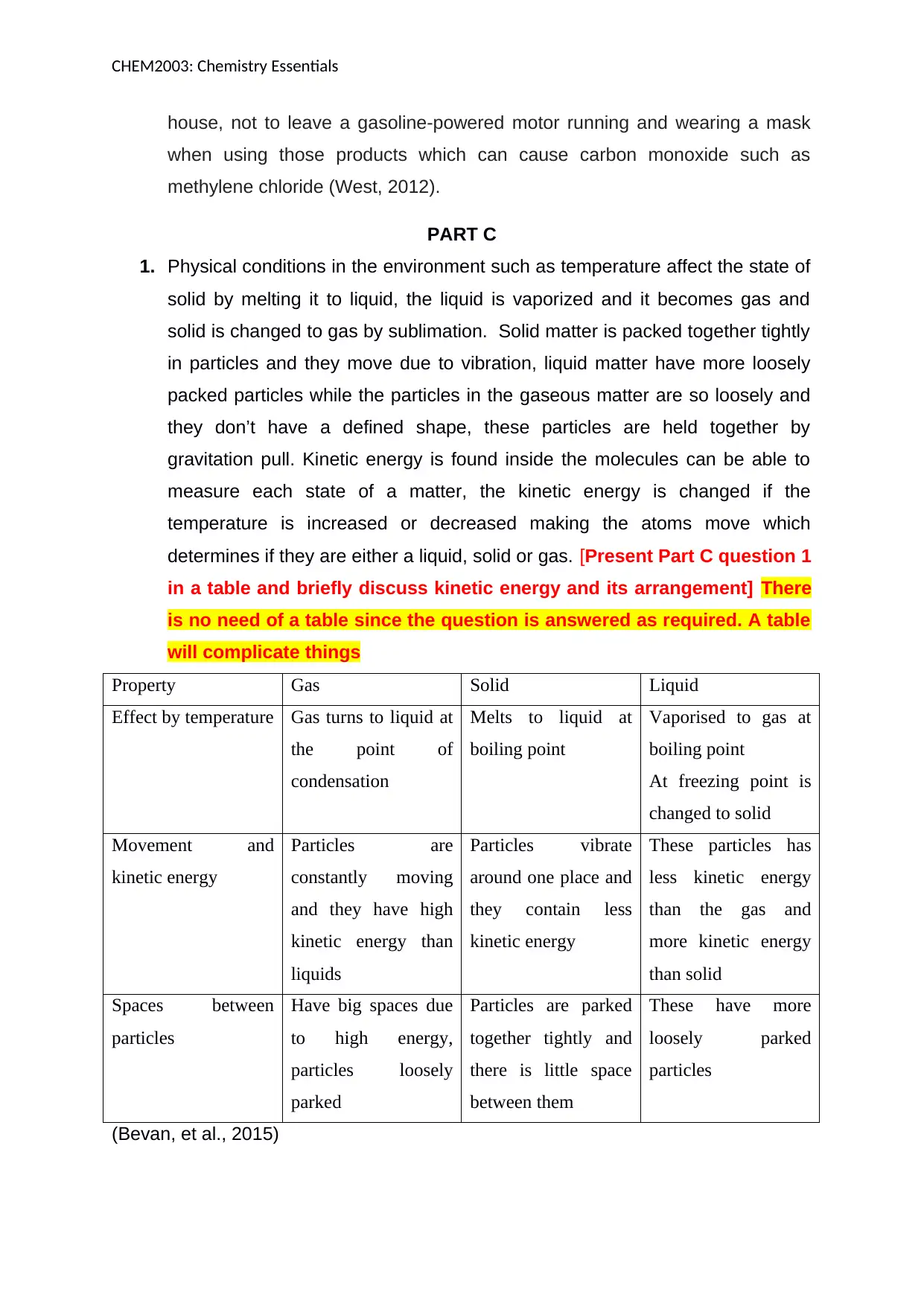
CHEM2003: Chemistry Essentials
house, not to leave a gasoline-powered motor running and wearing a mask
when using those products which can cause carbon monoxide such as
methylene chloride (West, 2012).
PART C
1. Physical conditions in the environment such as temperature affect the state of
solid by melting it to liquid, the liquid is vaporized and it becomes gas and
solid is changed to gas by sublimation. Solid matter is packed together tightly
in particles and they move due to vibration, liquid matter have more loosely
packed particles while the particles in the gaseous matter are so loosely and
they don’t have a defined shape, these particles are held together by
gravitation pull. Kinetic energy is found inside the molecules can be able to
measure each state of a matter, the kinetic energy is changed if the
temperature is increased or decreased making the atoms move which
determines if they are either a liquid, solid or gas. [Present Part C question 1
in a table and briefly discuss kinetic energy and its arrangement] There
is no need of a table since the question is answered as required. A table
will complicate things
Property Gas Solid Liquid
Effect by temperature Gas turns to liquid at
the point of
condensation
Melts to liquid at
boiling point
Vaporised to gas at
boiling point
At freezing point is
changed to solid
Movement and
kinetic energy
Particles are
constantly moving
and they have high
kinetic energy than
liquids
Particles vibrate
around one place and
they contain less
kinetic energy
These particles has
less kinetic energy
than the gas and
more kinetic energy
than solid
Spaces between
particles
Have big spaces due
to high energy,
particles loosely
parked
Particles are parked
together tightly and
there is little space
between them
These have more
loosely parked
particles
(Bevan, et al., 2015)
house, not to leave a gasoline-powered motor running and wearing a mask
when using those products which can cause carbon monoxide such as
methylene chloride (West, 2012).
PART C
1. Physical conditions in the environment such as temperature affect the state of
solid by melting it to liquid, the liquid is vaporized and it becomes gas and
solid is changed to gas by sublimation. Solid matter is packed together tightly
in particles and they move due to vibration, liquid matter have more loosely
packed particles while the particles in the gaseous matter are so loosely and
they don’t have a defined shape, these particles are held together by
gravitation pull. Kinetic energy is found inside the molecules can be able to
measure each state of a matter, the kinetic energy is changed if the
temperature is increased or decreased making the atoms move which
determines if they are either a liquid, solid or gas. [Present Part C question 1
in a table and briefly discuss kinetic energy and its arrangement] There
is no need of a table since the question is answered as required. A table
will complicate things
Property Gas Solid Liquid
Effect by temperature Gas turns to liquid at
the point of
condensation
Melts to liquid at
boiling point
Vaporised to gas at
boiling point
At freezing point is
changed to solid
Movement and
kinetic energy
Particles are
constantly moving
and they have high
kinetic energy than
liquids
Particles vibrate
around one place and
they contain less
kinetic energy
These particles has
less kinetic energy
than the gas and
more kinetic energy
than solid
Spaces between
particles
Have big spaces due
to high energy,
particles loosely
parked
Particles are parked
together tightly and
there is little space
between them
These have more
loosely parked
particles
(Bevan, et al., 2015)
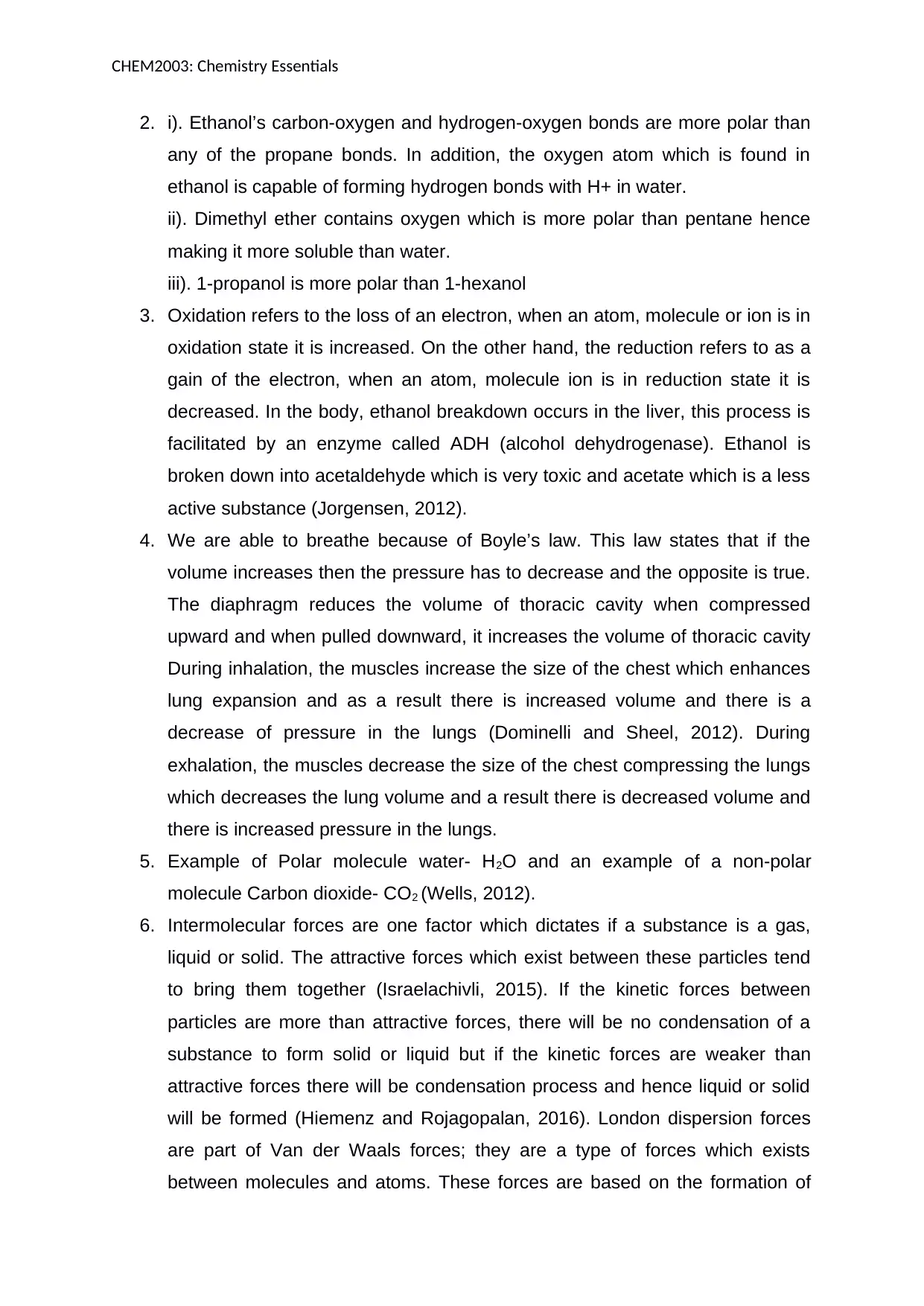
CHEM2003: Chemistry Essentials
2. i). Ethanol’s carbon-oxygen and hydrogen-oxygen bonds are more polar than
any of the propane bonds. In addition, the oxygen atom which is found in
ethanol is capable of forming hydrogen bonds with H+ in water.
ii). Dimethyl ether contains oxygen which is more polar than pentane hence
making it more soluble than water.
iii). 1-propanol is more polar than 1-hexanol
3. Oxidation refers to the loss of an electron, when an atom, molecule or ion is in
oxidation state it is increased. On the other hand, the reduction refers to as a
gain of the electron, when an atom, molecule ion is in reduction state it is
decreased. In the body, ethanol breakdown occurs in the liver, this process is
facilitated by an enzyme called ADH (alcohol dehydrogenase). Ethanol is
broken down into acetaldehyde which is very toxic and acetate which is a less
active substance (Jorgensen, 2012).
4. We are able to breathe because of Boyle’s law. This law states that if the
volume increases then the pressure has to decrease and the opposite is true.
The diaphragm reduces the volume of thoracic cavity when compressed
upward and when pulled downward, it increases the volume of thoracic cavity
During inhalation, the muscles increase the size of the chest which enhances
lung expansion and as a result there is increased volume and there is a
decrease of pressure in the lungs (Dominelli and Sheel, 2012). During
exhalation, the muscles decrease the size of the chest compressing the lungs
which decreases the lung volume and a result there is decreased volume and
there is increased pressure in the lungs.
5. Example of Polar molecule water- H2O and an example of a non-polar
molecule Carbon dioxide- CO2 (Wells, 2012).
6. Intermolecular forces are one factor which dictates if a substance is a gas,
liquid or solid. The attractive forces which exist between these particles tend
to bring them together (Israelachivli, 2015). If the kinetic forces between
particles are more than attractive forces, there will be no condensation of a
substance to form solid or liquid but if the kinetic forces are weaker than
attractive forces there will be condensation process and hence liquid or solid
will be formed (Hiemenz and Rojagopalan, 2016). London dispersion forces
are part of Van der Waals forces; they are a type of forces which exists
between molecules and atoms. These forces are based on the formation of
2. i). Ethanol’s carbon-oxygen and hydrogen-oxygen bonds are more polar than
any of the propane bonds. In addition, the oxygen atom which is found in
ethanol is capable of forming hydrogen bonds with H+ in water.
ii). Dimethyl ether contains oxygen which is more polar than pentane hence
making it more soluble than water.
iii). 1-propanol is more polar than 1-hexanol
3. Oxidation refers to the loss of an electron, when an atom, molecule or ion is in
oxidation state it is increased. On the other hand, the reduction refers to as a
gain of the electron, when an atom, molecule ion is in reduction state it is
decreased. In the body, ethanol breakdown occurs in the liver, this process is
facilitated by an enzyme called ADH (alcohol dehydrogenase). Ethanol is
broken down into acetaldehyde which is very toxic and acetate which is a less
active substance (Jorgensen, 2012).
4. We are able to breathe because of Boyle’s law. This law states that if the
volume increases then the pressure has to decrease and the opposite is true.
The diaphragm reduces the volume of thoracic cavity when compressed
upward and when pulled downward, it increases the volume of thoracic cavity
During inhalation, the muscles increase the size of the chest which enhances
lung expansion and as a result there is increased volume and there is a
decrease of pressure in the lungs (Dominelli and Sheel, 2012). During
exhalation, the muscles decrease the size of the chest compressing the lungs
which decreases the lung volume and a result there is decreased volume and
there is increased pressure in the lungs.
5. Example of Polar molecule water- H2O and an example of a non-polar
molecule Carbon dioxide- CO2 (Wells, 2012).
6. Intermolecular forces are one factor which dictates if a substance is a gas,
liquid or solid. The attractive forces which exist between these particles tend
to bring them together (Israelachivli, 2015). If the kinetic forces between
particles are more than attractive forces, there will be no condensation of a
substance to form solid or liquid but if the kinetic forces are weaker than
attractive forces there will be condensation process and hence liquid or solid
will be formed (Hiemenz and Rojagopalan, 2016). London dispersion forces
are part of Van der Waals forces; they are a type of forces which exists
between molecules and atoms. These forces are based on the formation of
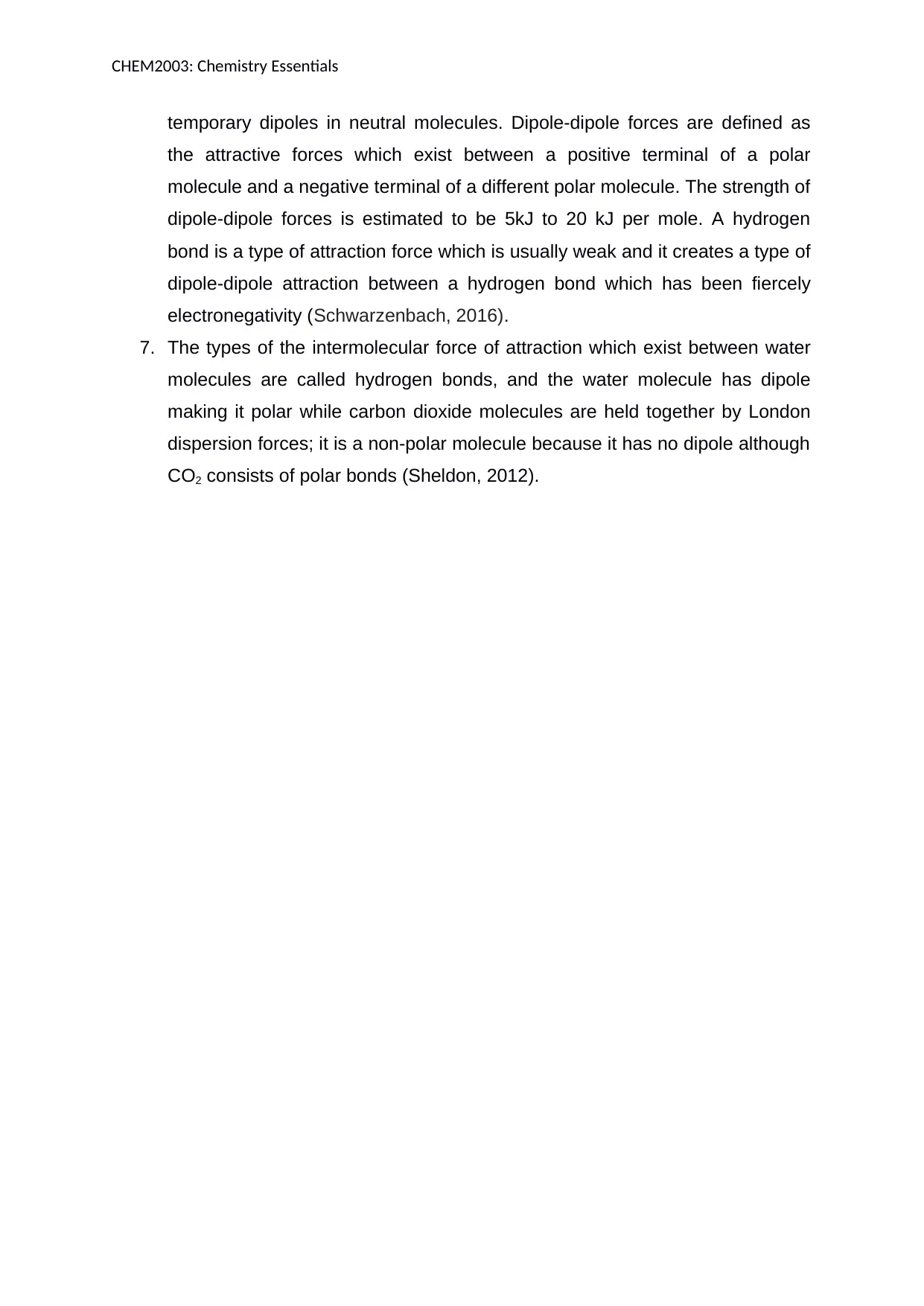
CHEM2003: Chemistry Essentials
temporary dipoles in neutral molecules. Dipole-dipole forces are defined as
the attractive forces which exist between a positive terminal of a polar
molecule and a negative terminal of a different polar molecule. The strength of
dipole-dipole forces is estimated to be 5kJ to 20 kJ per mole. A hydrogen
bond is a type of attraction force which is usually weak and it creates a type of
dipole-dipole attraction between a hydrogen bond which has been fiercely
electronegativity (Schwarzenbach, 2016).
7. The types of the intermolecular force of attraction which exist between water
molecules are called hydrogen bonds, and the water molecule has dipole
making it polar while carbon dioxide molecules are held together by London
dispersion forces; it is a non-polar molecule because it has no dipole although
CO2 consists of polar bonds (Sheldon, 2012).
temporary dipoles in neutral molecules. Dipole-dipole forces are defined as
the attractive forces which exist between a positive terminal of a polar
molecule and a negative terminal of a different polar molecule. The strength of
dipole-dipole forces is estimated to be 5kJ to 20 kJ per mole. A hydrogen
bond is a type of attraction force which is usually weak and it creates a type of
dipole-dipole attraction between a hydrogen bond which has been fiercely
electronegativity (Schwarzenbach, 2016).
7. The types of the intermolecular force of attraction which exist between water
molecules are called hydrogen bonds, and the water molecule has dipole
making it polar while carbon dioxide molecules are held together by London
dispersion forces; it is a non-polar molecule because it has no dipole although
CO2 consists of polar bonds (Sheldon, 2012).
Paraphrase This Document
Need a fresh take? Get an instant paraphrase of this document with our AI Paraphraser
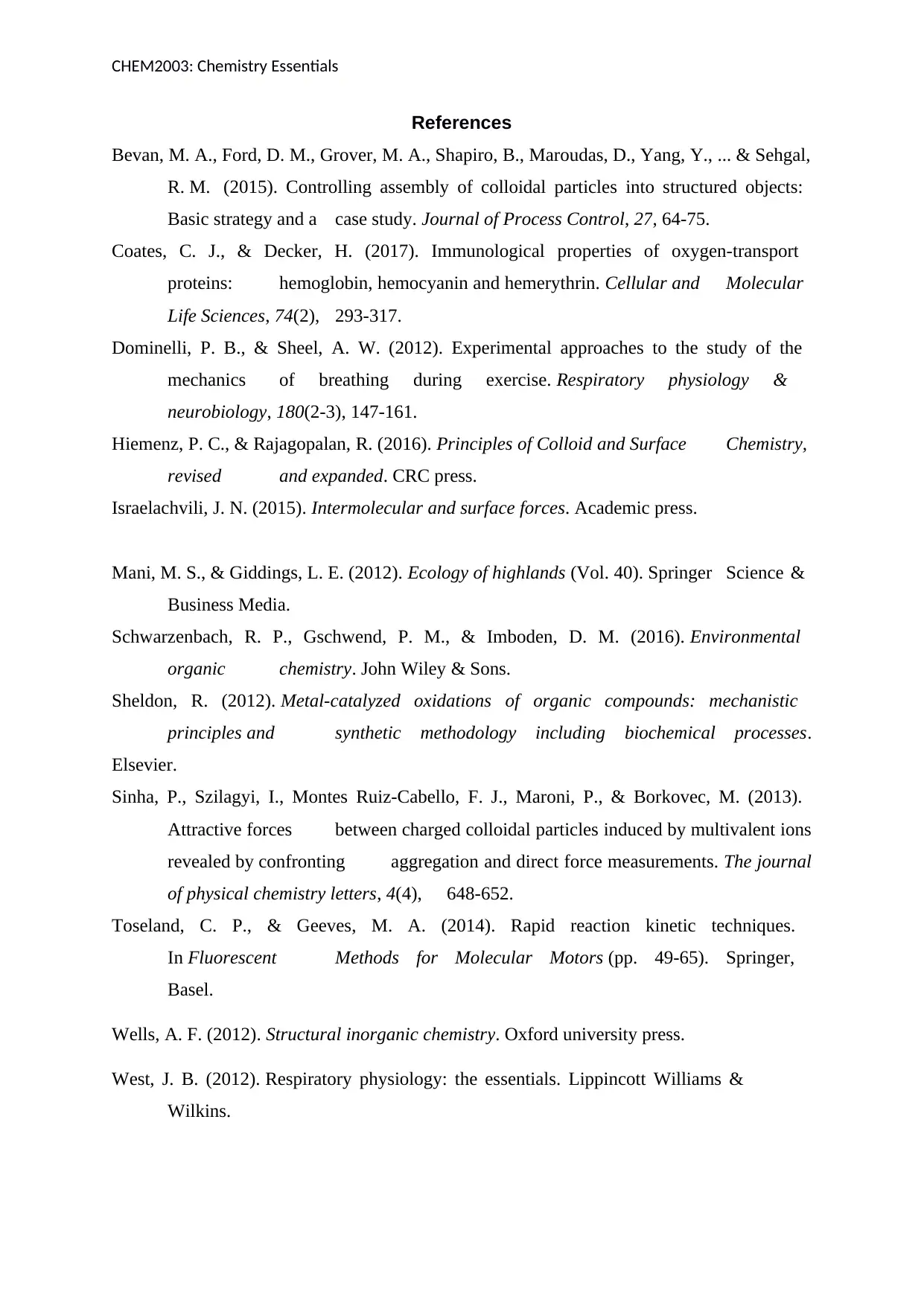
CHEM2003: Chemistry Essentials
References
Bevan, M. A., Ford, D. M., Grover, M. A., Shapiro, B., Maroudas, D., Yang, Y., ... & Sehgal,
R. M. (2015). Controlling assembly of colloidal particles into structured objects:
Basic strategy and a case study. Journal of Process Control, 27, 64-75.
Coates, C. J., & Decker, H. (2017). Immunological properties of oxygen-transport
proteins: hemoglobin, hemocyanin and hemerythrin. Cellular and Molecular
Life Sciences, 74(2), 293-317.
Dominelli, P. B., & Sheel, A. W. (2012). Experimental approaches to the study of the
mechanics of breathing during exercise. Respiratory physiology &
neurobiology, 180(2-3), 147-161.
Hiemenz, P. C., & Rajagopalan, R. (2016). Principles of Colloid and Surface Chemistry,
revised and expanded. CRC press.
Israelachvili, J. N. (2015). Intermolecular and surface forces. Academic press.
Mani, M. S., & Giddings, L. E. (2012). Ecology of highlands (Vol. 40). Springer Science &
Business Media.
Schwarzenbach, R. P., Gschwend, P. M., & Imboden, D. M. (2016). Environmental
organic chemistry. John Wiley & Sons.
Sheldon, R. (2012). Metal-catalyzed oxidations of organic compounds: mechanistic
principles and synthetic methodology including biochemical processes.
Elsevier.
Sinha, P., Szilagyi, I., Montes Ruiz-Cabello, F. J., Maroni, P., & Borkovec, M. (2013).
Attractive forces between charged colloidal particles induced by multivalent ions
revealed by confronting aggregation and direct force measurements. The journal
of physical chemistry letters, 4(4), 648-652.
Toseland, C. P., & Geeves, M. A. (2014). Rapid reaction kinetic techniques.
In Fluorescent Methods for Molecular Motors (pp. 49-65). Springer,
Basel.
Wells, A. F. (2012). Structural inorganic chemistry. Oxford university press.
West, J. B. (2012). Respiratory physiology: the essentials. Lippincott Williams &
Wilkins.
References
Bevan, M. A., Ford, D. M., Grover, M. A., Shapiro, B., Maroudas, D., Yang, Y., ... & Sehgal,
R. M. (2015). Controlling assembly of colloidal particles into structured objects:
Basic strategy and a case study. Journal of Process Control, 27, 64-75.
Coates, C. J., & Decker, H. (2017). Immunological properties of oxygen-transport
proteins: hemoglobin, hemocyanin and hemerythrin. Cellular and Molecular
Life Sciences, 74(2), 293-317.
Dominelli, P. B., & Sheel, A. W. (2012). Experimental approaches to the study of the
mechanics of breathing during exercise. Respiratory physiology &
neurobiology, 180(2-3), 147-161.
Hiemenz, P. C., & Rajagopalan, R. (2016). Principles of Colloid and Surface Chemistry,
revised and expanded. CRC press.
Israelachvili, J. N. (2015). Intermolecular and surface forces. Academic press.
Mani, M. S., & Giddings, L. E. (2012). Ecology of highlands (Vol. 40). Springer Science &
Business Media.
Schwarzenbach, R. P., Gschwend, P. M., & Imboden, D. M. (2016). Environmental
organic chemistry. John Wiley & Sons.
Sheldon, R. (2012). Metal-catalyzed oxidations of organic compounds: mechanistic
principles and synthetic methodology including biochemical processes.
Elsevier.
Sinha, P., Szilagyi, I., Montes Ruiz-Cabello, F. J., Maroni, P., & Borkovec, M. (2013).
Attractive forces between charged colloidal particles induced by multivalent ions
revealed by confronting aggregation and direct force measurements. The journal
of physical chemistry letters, 4(4), 648-652.
Toseland, C. P., & Geeves, M. A. (2014). Rapid reaction kinetic techniques.
In Fluorescent Methods for Molecular Motors (pp. 49-65). Springer,
Basel.
Wells, A. F. (2012). Structural inorganic chemistry. Oxford university press.
West, J. B. (2012). Respiratory physiology: the essentials. Lippincott Williams &
Wilkins.

CHEM2003: Chemistry Essentials
1 out of 9
Your All-in-One AI-Powered Toolkit for Academic Success.
+13062052269
info@desklib.com
Available 24*7 on WhatsApp / Email
![[object Object]](/_next/static/media/star-bottom.7253800d.svg)
Unlock your academic potential
© 2024 | Zucol Services PVT LTD | All rights reserved.


